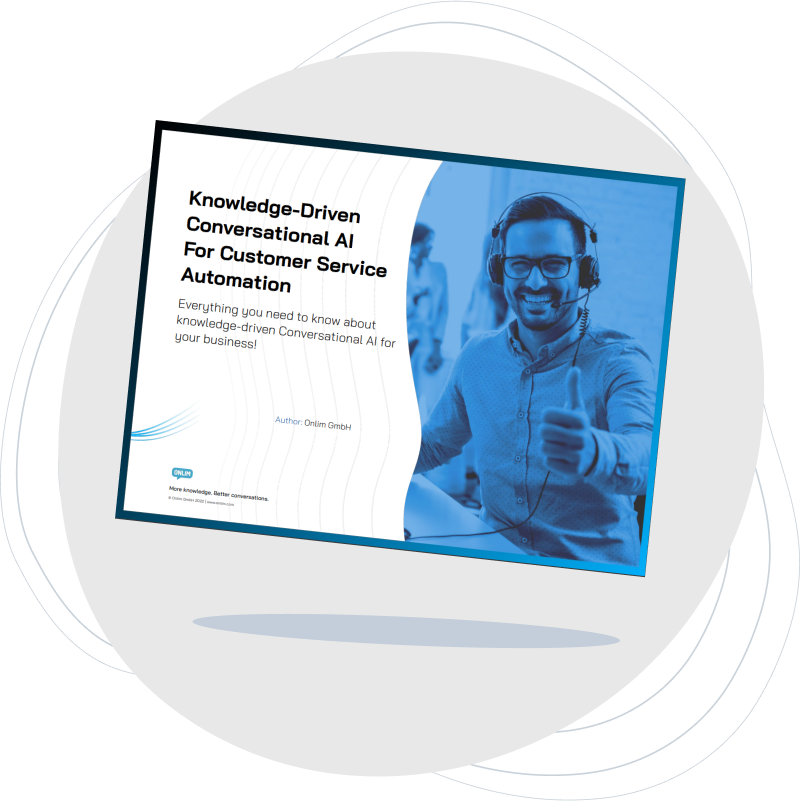Knowledge-Driven Conversational AI For Customer Service Automation
Everything you need to know about knowledge-driven Conversational AI for your business!

“Conversational AI is more than a new tool. It brings about a full-scale transformation process that will permanently change the way we gather information and manage knowledge.”
Alexander Wahler | CEO Onlim
SMART CUSTOMER COMMUNICATION
What you can expect:
In the e-book “Knowledge-driven Conversational AI for Customer Service Automation”, you will learn what opportunities Conversational AI offers companies and get important tips for implementation.
In the e-book “The Ultimate Chatbot Guide”, you will learn what opportunities chatbots offer companies for internal as well as external use cases and get important tips for implementation.
Introduction
Why do companies need to think about and engage with technologies like Conversational AI and what is the status quo?Artificial intelligence has reached a stage where humans can effortlessly interact with automated systems or conversational interfaces such as chatbots or voice assistants. With the benefits of an intelligent, automated, and 24/7 available communication channel, more and more businesses are using Conversational AI.
Conversational AI Technology
What is Conversational AI and what technology components does it consist of?Conversational AI refers to applications foms of AI technologies that enable automated, natural language-based dialogues via systems such as chatbots or voice assistants. Technology components such as NLU, Intent & Entity Recognition, Machine Learning, and especially Knowledge Graphs play an important role in successful Conversational AI.
The Conversational AI Market
What does the global Conversational market look like right now and what can we expect in the future?The global Conversational AI market is expected to grow from USD 6.8 billion in 2021 to USD 18.4 billion in 2026 at a compound annual growth rate (CAGR) of 21.8%. This market growth can be primarily attributed to the growing need for 24/7 customer support and advancements in technology coupled with rising customer demand for self-service processes.
Knowledge-Driven Conversational AI
How can we not only enable conversations between humans and machines, but also improve them?Companies are faced with the challenge of generating knowledge from information and making it machine-readable and easily accessible. This is where the symbiosis between Knowledge Graphs and Conversational AI comes into play. Conversations and knowledge are closely linked: without knowledge, there are no meaningful conversations, without conversations less knowledge can be generated, and no insights can be gained.
Use Cases
Which use cases are there for Conversational AI in various industries?Conversational AI offers a wide range of uses and are not limited to one industry or use case. It is already successfully used in customer service, marketing & sales, human resources and IT service help desks. You can find concrete use cases and examples in the ebook.
Expert Tips
What do you need to consider when implementing Conversational AI? What are the crucial tips to follow?When implemented correctly, knowledge-based Conversational AI allows users to “talk to machines” in natural language and get a correct answer even when new situations arise. Our expert tips will ensure that your Conversational AI project is a success.
Introduction
Why do companies need to think about and engage with technologies like Conversational AI and what is the status quo?Artificial intelligence has reached a stage where humans can effortlessly interact with automated systems or conversational interfaces such as chatbots or voice assistants. With the benefits of an intelligent, automated, and 24/7 available communication channel, more and more businesses are using Conversational AI.
Conversational AI Technology
What is Conversational AI and what technology components does it consist of?Conversational AI refers to applications foms of AI technologies that enable automated, natural language-based dialogues via systems such as chatbots or voice assistants. Technology components such as NLU, Intent & Entity Recognition, Machine Learning, and especially Knowledge Graphs play an important role in successful Conversational AI.
The Conversational AI Market
What does the global Conversational market look like right now and what can we expect in the future?The global Conversational AI market is expected to grow from USD 6.8 billion in 2021 to USD 18.4 billion in 2026 at a compound annual growth rate (CAGR) of 21.8%. This market growth can be primarily attributed to the growing need for 24/7 customer support and advancements in technology coupled with rising customer demand for self-service processes.
Knowledge-Driven Conversational AI
How can we not only enable conversations between humans and machines, but also improve them?Companies are faced with the challenge of generating knowledge from information and making it machine-readable and easily accessible. This is where the symbiosis between Knowledge Graphs and Conversational AI comes into play. Conversations and knowledge are closely linked: without knowledge, there are no meaningful conversations, without conversations less knowledge can be generated, and no insights can be gained.
Use Cases
Which use cases are there for Conversational AI in various industries?Conversational AI offers a wide range of uses and are not limited to one industry or use case. It is already successfully used in customer service, marketing & sales, human resources and IT service help desks. You can find concrete use cases and examples in the ebook.
Expert Tips
What do you need to consider when implementing Conversational AI? What are the crucial tips to follow?When implemented correctly, knowledge-based Conversational AI allows users to “talk to machines” in natural language and get a correct answer even when new situations arise. Our expert tips will ensure that your Conversational AI project is a success.
“Conversational AI is the next wave of customer and employee experiences.”
Deloitte
